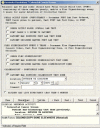Exploring barriers and facilitators to the use of computerized clinical reminders
- PMID: 15802482
- PMCID: PMC1174889
- DOI: 10.1197/jamia.M1777
Exploring barriers and facilitators to the use of computerized clinical reminders
Abstract
Objective: Evidence-based practices in preventive care and chronic disease management are inconsistently implemented. Computerized clinical reminders (CRs) can improve compliance with these practices in outpatient settings. However, since clinician adherence to CR recommendations is quite variable and declines over time, we conducted observations to determine barriers and facilitators to the effective use of CRs.
Design: We conducted an observational study of nurses and providers interacting with CRs in outpatient primary care clinics for two days in each of four geographically distributed Veterans Administration (VA) medical centers.
Measurements: Three observers recorded interactions of 35 nurses and 55 physicians and mid-level practitioners with the CRs, which function as part of an electronic medical record. Field notes were typed, coded in a spreadsheet, and then sorted into logical categories. We then integrated findings across observations into meaningful patterns and abstracted the data into themes, such as recurrent strategies. Several of these themes translated directly to barriers and facilitators to effective CR use.
Results: Optimally using the CR system for its intended purpose was impeded by (1) lack of coordination between nurses and providers; (2) using the reminders while not with the patient, impairing data acquisition and/or implementation of recommended actions; (3) workload; (4) lack of CR flexibility; and (5) poor interface usability. Facilitators included (1) limiting the number of reminders at a site; (2) strategic location of the computer workstations; (3) integration of reminders into workflow; and (4) the ability to document system problems and receive prompt administrator feedback.
Conclusion: We identified barriers that might explain some of the variability in the use of CRs. Although these barriers may be difficult to overcome, some strategies may increase user acceptance and therefore the effectiveness of the CRs. These include explicitly assigning responsibility for each CR to nurses or providers, improving visibility of positive results from CRs in the electronic medical record, creating a feedback mechanism about CR use, and limiting the overall number of CRs.
Figures



References
-
- McGlynn EA, Asch SM, Adams J, et al. The quality of health care delivered to adults in the United States. N Engl J Med. 2003;348:2635–45. - PubMed
-
- Hunt DL, Haynes RB, Hanna SE, Smith K. Effects of computer-based clinical decision support systems on physician performance and patient outcomes. JAMA. 1998;280:1339–46. - PubMed
-
- Demakis JG, Beauchamp C, Cull WL, et al. Improving residents' compliance with standards of ambulatory care: results from the VA cooperative study on computerized reminders. JAMA. 2000;284:1411–6. - PubMed
-
- Agrawal A, Mayo-Smith MF. Adherence to computerized clinical reminders in a large healthcare delivery network. Medinfo. 2004:111–4. - PubMed
Publication types
MeSH terms
LinkOut - more resources
Full Text Sources

